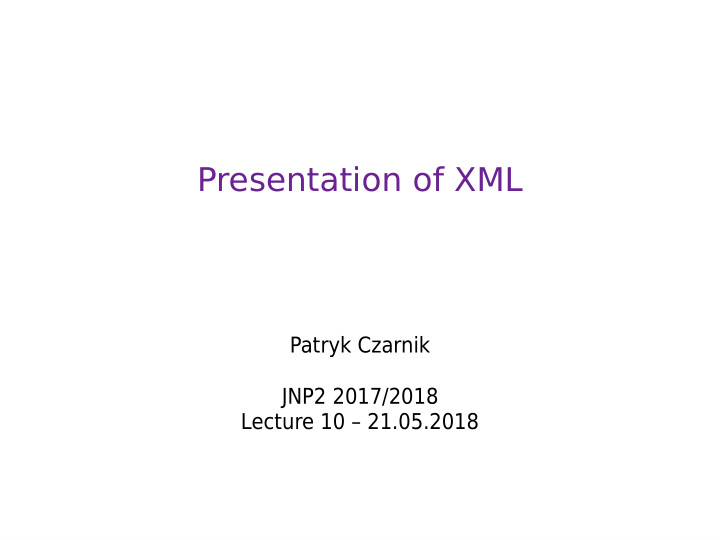



Presentation of XML Patryk Czarnik JNP2 2017/2018 Lecture 10 – 21.05.2018
Separation of content and formatting According to best XML practices: Documents consist of content / data. T ags are for structure and meaning (semantic tagging). e.g. <amount>2.99</amount> rather than <i>2.99</i> There is no direct formatting information. How to present documents? Generic (and poor) XML presentation methods XML source document tree unformatted text content Custom application handling a particular known class of documents Importing XML to text editors or DTP tools External style sheets 2 / 60
Idea of stylesheet <person position="expert" id="102103"> <fname>Dawid</fname><surname>Paszkiewicz</surname> <person position="expert" id="102105"> <phone type="offjce">+48223213203</phone> <fname>Marek</fname><surname>Kącki</surname> <phone type="mobile">+48501502503</phone> <phone type="offjce">+48223213212</phone> <email>paszkiewicz@example.com</email> <phone type="mobile">+48501502524</phone> </person> <email>kacki@example.com</email> </person> white background, blue frame ● yellow background, blue 3D frame ● font 'Times 10pt' ● font 'Bookman 12pt' ● 12pt for name ● phone numbers in single line ● abbreviation before phone number ● email in typewriter font ● email in italic ● no too much details ● position before name ● 3 / 60
Benefjts of content and formatting separation With semantic tagging – source data analysis easier and more reliable (than reverse-engineering of formatted text) Ability to easily present the same document after modifjcations other documents from the same class Changes in formatting applied easily modifjcations in one place – the stylesheet whole class of documents formatted consistently Alternative styles for the same class of documents, depending on media type (screen, printout, voice) details level reader preferences (or disabilities...) 4 / 60
Standards related to XML presentation Assigning style to document: Associating Style Sheets with XML documents Stylesheet languages: DSSSL (historical, used for SGML) Document Style Semantics and Specifjcation Language CSS Cascading Style Sheets XSL Extensible Stylesheet Language 5 / 60
Associating style with document Using xml-stylesheet processing instruction Defjned in W3C recommendation Associating Style Sheets with XML documents <?xml version="1.0" encoding="utf-8"?> <?xml-stylesheet type="text/css" href="blue.css" ?> <?xml-stylesheet title="Yellow" alternate="yes" type="text/css" href="yellow.css" ?> <?xml-stylesheet title="Pink" alternate="yes" type="text/css" href="pink.css" ?> <person> <fname>Arkadiusz</fname><name>Gierasimczyk</name> ... </person> 6 / 60
Cascading Style Sheets – history Roots of stylesheet idea – 1970s: translation of markup documents to (difgerent) printer languages Beginning of CSS: 1994 CSS Level 2: May 1998 CSS 2.1: June 2011 restricts CSS 2 and makes it more precise CSS Level 3: split into modules, some of them are fjnal recommendations, some are not 7 / 60
Applications of CSS First and major one: style for Web sites Separation of content and style for HTML (Simple) style sheets for XML CSS 2 and the idea of “accessibility”: support for difgerent media support for alternative presentation means (e.g. voice generation) enabling reader to override style proposed by author (reader rules) 8 / 60
Example stylesheet (fragment) <company> <name>Extremely professional staff</name> <department id="acc"> <name>Accountancy</name> <person position="expert" id="102103"> <fname>Dawid</fname><surname>Paszkiewicz</surname> <phone type="office">+48223213203</phone> <phone type="mobile">+48501502503</phone> <email>paszkiewicz@example.com</email> </person> <person position="chief" id="102104"> <fname>Monika</fname><surname>Domżałowicz</surname> <phone type="office">+48223213200</phone> <email>mdom@example.com</email> </person> </department> <main-office> ... </main-office> </company> 9 / 60
Example stylesheet (fragment) person { display: block; margin: 10px auto 10px 30px; padding: 0.75em 1em; width: 200px; border: solid 2px #002288; background-color: #FFFFFF; } person[position='chief'] { background-color: #DDFFDD; } fname, surname { display: inline; font-size: larger; } person[position='chief'] surname { font-weight: bold; } 10 / 60
Resulting visualisation 11 / 60
CSS selectors (representative examples) surname – element of the given name fname, surname – both elements company name – name being descendant of company company > name – name being direct child of company surname + phone – phone directly succeeding surname phone:first-child – phone being fjrst child of its parent person[position] – person owing position attribute person[position='manager'] – person with position attribute equal to manager person [roles~='manager'] – person with attribute role containing word manager (attribute as space-separated list) ol.staff – equivalent to ol[class~='staff'] (HTML only) person#k12 – person with ID (in DTD meaning) equal to k12 12 / 60
CSS capabilities and advantages Rich visual formatting features Selecting elements by name location in document tree attribute existence attribute values Good support internet browsers authoring tools Easy to write simple stylesheets :) 13 / 60
CSS shortcomings Only visualisation, not translation to difgerent formats Selectors relatively weak. Conditions not expressible in CSS: checking content of element, e.g.: element A that contains element B element A that contains text abc logical composition of many conditions (available to some extent, but inconvenient) value comparison (e.g. show negative amounts in red) Structure of blocks directly based on structure of source elts reordering of elements hard (and not possible in general way) not possible to show one element several times on page No data processing. Not available for example: number calculations (summing etc.) operations on text (shortening, regexp matching, etc.) 14 / 60
Presentation by transformation <xsl:template> <h2> <xsl:value-of> <table> <xsl:variable> <person> <tr> <fname> <name> <td> <salary> Defj nition of transformation (in role of styelsheet) Document for XML direct ("pure data") presentation 15 / 60
Extensible Stylesheet Language (XSL) Defjned in W3C recommendations (v1.0 in 1999 and 2001): XSL – general framework and XSL Formatting Objects XSL T – language for defjning XML transformations XPath – expression language, including paths for document fragments addressing Original approach: Transformation defjnition (XSLT), in the role of stylesheet, specifjes how a source document is translated into FO document. Presentation of result FO is specifjed by XSL-FO standard and available through a rendering engine. Practice: HTML result format used more often (although FO also used) XSLT and XPath also used for purposes other than presentation 16 / 60
Transformation to HTML – example (1) <xsl:stylesheet version="1.0" xmlns:xsl="http://www.w3.org/1999/XSL/Transform"> <xsl:output method="html" encoding="utf-8" /> <xsl:template match="/"> <html> <head> <title> Employees of <xsl:value-of select="/company/name"/> </title> <style type="text/css"> body { background-color: #FFFFDD; ... } div.person { margin: 10px auto 10px 30px; ... } ... </style> </head> <body> <xsl:apply-templates /> </body> </html> </xsl:template> 17 / 60
Transformation to HTML – example (2) <xsl:template match="person"> <xsl:variable name="mgr"> <xsl:if test="@position='manager'">manager</xsl:if> </xsl:variable> <div class="person {$mgr}"> <div class="name"> <xsl:apply-templates select="fname" /> <xsl:text> </xsl:text> <xsl:apply-templates select="surname" /> </div> <div class="phone"> <xsl:apply-templates select="phone" /> </div> <div class="email"> <xsl:apply-templates select="email" /> </div> </div> </xsl:template> 18 / 60
Recommend
More recommend